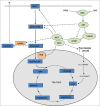Alteration of cellular metabolism in cancer cells and its therapeutic prospects
- PMID: 28932034
- PMCID: PMC5596675
- DOI: 10.4103/jomfp.JOMFP_60_17
Alteration of cellular metabolism in cancer cells and its therapeutic prospects
Abstract
Transformation of a normal cell into a cancerous phenotype is essentially backed by genetic mutations that trigger several oncogenic signaling pathways. These signaling pathways rewire the cellular metabolism to meet the bioenergetic and biomass requirement of proliferating cell, which is different from a quiescent cell. Although the change of metabolism in a cancer cell was observed and studied in the mid-20th century, it was not adequate to explain oncogenesis. Now, equipped with a revolution of oncogenes, we have a genetic basis to explain the transformation. Through several studies, it is clear now that such metabolic alterations not only promote cancer progression but also contribute to the chemoresistance of cancer. Targeting specific enzymes and combinations of enzymes can improve the efficacy of cancer therapy and help to overcome the therapeutic resistance.
Keywords: Cancer cell; metabolic alterations; therapeutics.
Conflict of interest statement
There are no conflicts of interest.
Figures



References
-
- Hanahan D, Weinberg RA. Hallmarks of cancer: The next generation. Cell. 2011;144:646–74. - PubMed
-
- Newsholme EA, Crabtree B, Ardawi MS. The role of high rates of glycolysis and glutamine utilization in rapidly dividing cells. Biosci Rep. 1985;5:393–400. - PubMed
-
- Tatum JL, Kelloff GJ, Gillies RJ, Arbeit JM, Brown JM, Chao KS, et al. Hypoxia: Importance in tumor biology, noninvasive measurement by imaging, and value of its measurement in the management of cancer therapy. Int J Radiat Biol. 2006;82:699–757. - PubMed
Publication types
LinkOut - more resources
Full Text Sources
Other Literature Sources

